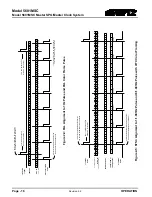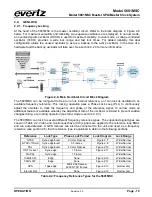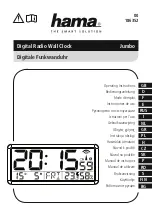
Model 5601MSC
Model 5601MSC Master SPG/Master Clock System
Page - 4
Revision 2.2
OVERVIEW
1.1.3. Configuring the Ethernet Ports
Press the
GENERAL
button on the front panel to access the general setup menu. This menu can be
used to configure the two Ethernet ports on the 5601MSC. Both the CONTROL port and the TIME port
are used for SNMP monitoring and control of the unit. If the
T
option is installed, both ports will host an
NTP server, while regular NTP broadcasts will be sent out on the CONTROL port only. The network
that the TIME port is connected to should contain very little traffic in order to obtain the lowest latencies.
The current menu selection will be indicated by the
>
character. Rotate the control knob or press the
and
buttons to select the
IP Control
menu item and press the
SELECT
button or depress the knob.
Assign an unused IP address and subnet mask to the CONTROL and TIME ports. The two ports must
be on separate subnets in order to function properly. When entering an IP address, the control knob
can be used to set each octet. Depress the control knob while turning to adjust in larger steps. The
Ethernet link status and current IP settings can be viewed by pressing the
STATUS
button and
selecting the
ControlEthernet
status screen or the
TimeEthernet
status screen.
If SNMP monitoring or control of the unit is desired, the SNMP feature must first be enabled (it is
disabled by default). Select the
GENERAL
menu and press
ESC
to return to the root menu. Scroll
down to
EngineeringMenu
and press
SELECT
. A password is required to enable the engineering menu
items. Press
SELECT
on
Password
and use the
and
buttons or control knob to enter each digit of
the numeric password and then press
SELECT
. The default password is 5601. The SNMP menu
should now be accessible and SNMP can be enabled through
SNMP Ctl
. The trap addresses must be
assigned if SNMP traps are required to be sent to remote logging software such as Vista
LINK
® Pro.
Contact Evertz customer service if a MIB to the 5601MSC is required.
1.1.4. Selecting and Connecting Frequency References
Pressing the
INPUT
button on the front panel will select the input menu. From here the frequency and
time references of the unit can be configured. Use the control knob to select the
Frequency Ref
menu
item and press
SELECT
or depress the knob. The
Reference Src
menu item selects four different ways
the 5601MSC can lock its master oscillator.
•
GPS
– The 5601MSC will look for a GPS antenna attached to the GPS port on the back of the
unit. The ovenized oscillator inside the unit will lock to the 1PPS pulse from the GPS antenna.
This provides a very accurate frequency reference to the unit. The high precision time and date
provided by the GPS antenna is used to phase the outputs of the 5601MSC by referencing them
to a specific point in GPS time. Multiple 5601MSC units locked to GPS will all have the same
phase on their outputs. This also means the time reference will be forced to GPS.
•
10 MHz
– The 5601MSC will look for a 5MHz or 10MHz reference on its reference loop input.
The 5MHz/10MHz reference should come from a source that has higher stability than the
internal oscillator of the 5601MSC such as a Rubidium or Cesium frequency standard. A 5MHz
or 10MHz reference does not provide any phase information and the phase of the outputs will
not be the same between different 5601MSC units (see section 4.3.3).
•
Video
– The 5601MSC will genlock to an analog black burst or HD tri-level reference applied to
its reference loop input. The frequency stability of the 5601MSC will be only as good as that of
the reference input. The phase of the outputs will be aligned to that of the reference input,
including color frame alignment and AES phase alignment if a ten-field pulse is detected.
•
Internal
– The 5601MSC will free run on its internal high stability ovenized oscillator. Select this
option if no external reference is available to the unit.
















































